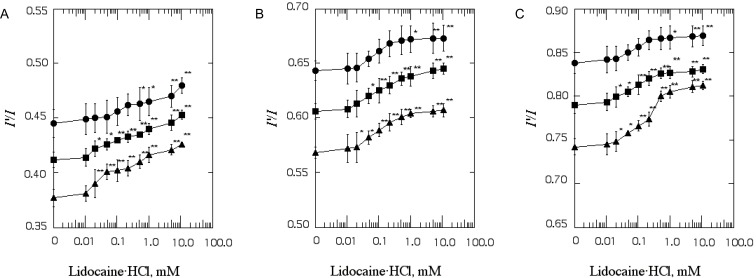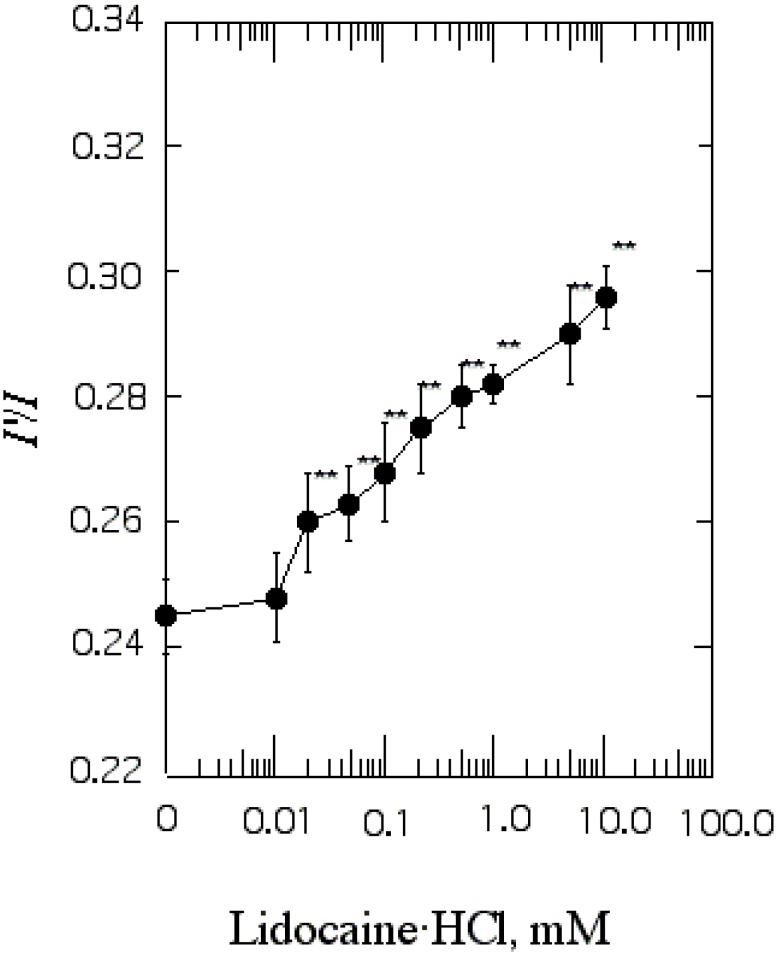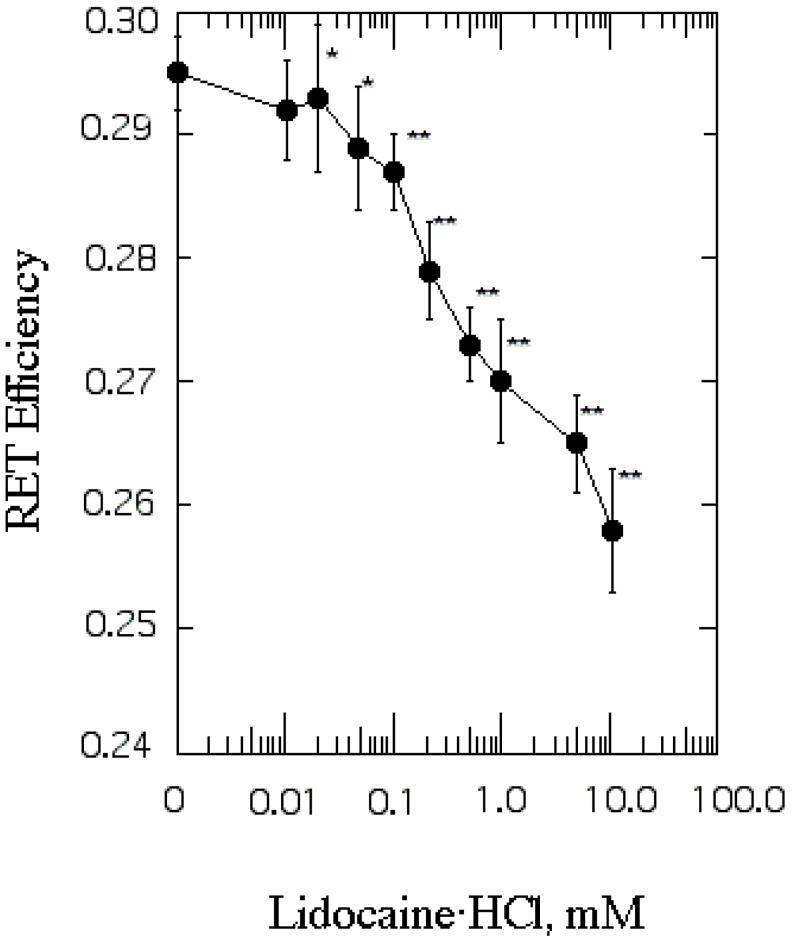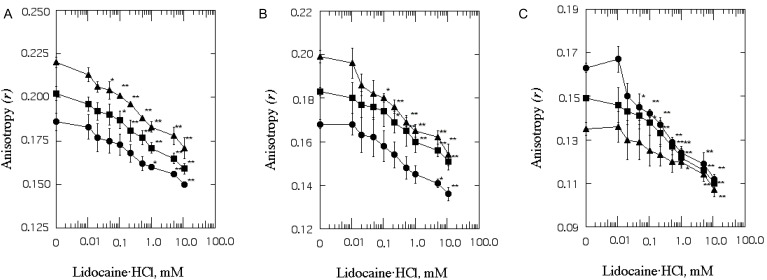Korean J Physiol Pharmacol.
2012 Dec;16(6):413-422. 10.4196/kjpp.2012.16.6.413.
The Effect of Lidocaine.HCl on the Fluidity of Native and Model Membrane Lipid Bilayers
- Affiliations
-
- 1Department of Dental Pharmacology and Biophysics, College of Pharmacy, Chung-Ang University, Seoul 156-756, Korea. iyun@pusan.ac.kr, jho9612@pusan.ac.kr
- 2Department of Oral and Maxillofacial Surgery and Clinical Pharmacology, College of Pharmacy, Chung-Ang University, Seoul 156-756, Korea.
- 3Department of Pharmacology, College of Pharmacy, Chung-Ang University, Seoul 156-756, Korea.
- 4Department of Oral Physiology and Molecular Biology, School of Dentistry and Research Institute for Oral Biotechnology, Yangsan Campus of Pusan National University, Yangsan 626-870, Korea. mkbae@pusan.ac.kr
- KMID: 2285450
- DOI: http://doi.org/10.4196/kjpp.2012.16.6.413
Abstract
- The purpose of this study is to investigated the mechanism of pharmacological action of local anesthetic and provide the basic information about the development of new effective local anesthetics. Fluorescent probe techniques were used to evaluate the effect of lidocaine.HCl on the physical properties (transbilayer asymmetric lateral and rotational mobility, annular lipid fluidity and protein distribution) of synaptosomal plasma membrane vesicles (SPMV) isolated from bovine cerebral cortex, and liposomes of total lipids (SPMVTL) and phospholipids (SPMVPL) extracted from the SPMV. An experimental procedure was used based on selective quenching of 1,3-di(1-pyrenyl)propane (Py-3-Py) and 1,6-diphenyl-1,3,5-hexatriene (DPH) by trinitrophenyl groups, and radiationless energy transfer from the tryptophans of membrane proteins to Py-3-Py. Lidocaine.HCl increased the bulk lateral and rotational mobility of neuronal and model membrane lipid bilayes, and had a greater fluidizing effect on the inner monolayer than the outer monolayer. Lidocaine.HCl increased annular lipid fluidity in SPMV lipid bilayers. It also caused membrane proteins to cluster. The most important finding of this study is that there is far greater increase in annular lipid fluidity than that in lateral and rotational mobilities by lidocaine.HCl. Lidocaine.HCl alters the stereo or dynamics of the proteins in the lipid bilayers by combining with lipids, especially with the annular lipids. In conclusion, the present data suggest that lidocaine, in addition to its direct interaction with proteins, concurrently interacts with membrane lipids, fluidizing the membrane, and thus inducing conformational changes of proteins known to be intimately associated with membrane lipid.
Keyword
MeSH Terms
-
Anesthetics, Local
Cell Membrane
Cerebral Cortex
Diphenylhexatriene
Energy Transfer
Lidocaine
Lipid Bilayers
Liposomes
Membrane Lipids
Membrane Proteins
Membranes
Neurons
Phospholipids
Proteins
Tryptophan
Anesthetics, Local
Diphenylhexatriene
Lidocaine
Lipid Bilayers
Liposomes
Membrane Lipids
Membrane Proteins
Phospholipids
Proteins
Tryptophan
Figure
Reference
-
1. Strichartz GR. The inhibition of sodium currents in myelinated nerve by quaternary derivatives of lidocaine. J Gen Physiol. 1973; 62:37–57. PMID: 4541340.
Article2. Butterworth JF 4th, Strichartz GR. Molecular mechanisms of local anesthesia: a review. Anesthesiology. 1990; 72:711–734. PMID: 2157353.3. Lee YH, Park NS, Kwon JD, Park JS, Shin GB, Lee CS, Jung TS, Choi NJ, Yoon JH, Ok JS, Yoon UC, Bae MK, Jang HO, Yun I. Amphiphilic effects of dibucaine HCl on rotational mobility of n-(9-anthroyloxy)stearic acid in neuronal and model membranes. Chem Phys Lipids. 2007; 146:33–42. PMID: 17241620.4. Lee JH, Kim DI, Mun H, Lee SK, Park JS, Kim JH, Lee JH, Park YH, Jeon YC, Yoon UC, Bae MK, Jang HO, Wood WG, Yun I. The effect of propoxycaine.HCl on the physical properties of neuronal membranes. Chem Phys Lipids. 2008; 154:19–25. PMID: 18407836.
Article5. Seeman P. The membrane actions of anesthetics and tranquilizers. Pharmacol Rev. 1972; 24:583–655. PMID: 4565956.7. Singer MA. Interaction of dibucaine and propranolol with phospholipid bilayer membranes-effect of alterations in fatty acyl composition. Biochem Pharmacol. 1977; 26:51–57. PMID: 188426.
Article8. Yun I, Han SK, Baek SW, Kim NH, Kang JS, Chung IK, Lee EJ. Effects of local anesthetics on the fluidity of synaptosomal plasma membrane vesicles isolated from bovine brain. Korean J Pharmacol. 1987; 24:43–52.9. Smith IC, Auger M, Jarrell HC. Molecular details of anesthetic-lipid interaction. Ann N Y Acad Sci. 1991; 625:668–684. PMID: 2058915.
Article10. Strichartz GR, Richie JM. Strichartz GR, editor. The action of local anesthetics on ion channels of excitable tissues. Local anesthetics. 1987. New York: Springer-Verlag;p. 21–52.
Article11. Miller KW, Braswell LM, Firestone LL, Dodson BA, Forman SA. Roth H, editor. Molecular and Cellular Mechanisms of Anesthetics. 1986. New York: Plenum;p. 157–171.12. Yun I, Kang JS. The general lipid composition and aminophospholipid asymmetry of synaptosomal plasma membrane vesicles isolated from bovine cerebral cortex. Mol Cells. 1990; 1:15–20.13. Kang JS, Choi CM, Yun I. Effects of ethanol on lateral and rotational mobility of plasma membrane vesicles isolated from cultured mouse myeloma cell line Sp2/0-Ag14. Biochim Biophys Acta. 1996; 1281:157–163. PMID: 8664314.
Article14. Yun I, Kim YS, Yu SH, Chung IK, Kim IS, Baik SW, Cho GJ, Chung YZ, Kim SH, Kang JS. Comparision of several procedures for the preparation of synaptosomal plasma membrane vesicles. Arch Pharm Res. 1990; 13:325–329.15. Jang HO, Shin HG, Yun I. Effects of dimyristoylphosphatidylethanol on the structural parameters of neuronal membranes. Mol Cells. 2004; 17:485–491. PMID: 15232224.16. Jang HO, Jeong DK, Ahn SH, Yoon CD, Jeong SC, Jin SD, Yun I. Effects of chlorpromazine HCl on the structural parameters of bovine brain membranes. J Biochem Mol Biol. 2004; 37:603–611. PMID: 15479625.17. Bae MK, Jeong DK, Park NS, Lee CH, Cho BH, Jang HO, Yun I. The effect of ethanol on the physical properties of neuronal membranes. Mol Cells. 2005; 19:356–364. PMID: 15995352.18. Yun I, Cho ES, Jang HO, Kim UK, Choi CH, Chung IK, Kim IS, Wood WG. Amphiphilic effects of local anesthetics on rotational mobility in neuronal and model membranes. Biochim Biophys Acta. 2002; 1564:123–132. PMID: 12101004.
Article19. Lowry OH, Rosebrough NJ, Farr AL, Randall RJ. Protein measurement with the Folin phenol reagent. J Biol Chem. 1951; 193:265–275. PMID: 14907713.
Article20. Huang TC, Chen CP, Wefler V, Raftery A. A stable reagent for the Liebermann-Burchard reaction. Anal Chem. 1961; 33:1405–1407.21. Bartlett GR. Phosphorus assay in column chromatography. J Biol Chem. 1959; 234:466–468. PMID: 13641241.
Article22. Madeira VMC, Antunes-Madeira MC. Lipid composition of biomembranes: a complete analysis of sarcoplasmic reticulum phospholipids. Cienc Biol (Coimbra). 1976; 2:265–291.23. Angelova ML, Dimitrov DS. Liposome electroformation. Faraday Discuss Chem Soc. 1986; 81:303–311.
Article24. Dimitrov DS, Angelova MI. Lipid swelling and liposome formation on solid surfaces in external electric fields. Progr Colloid Polym Sci. 1987; 73:48–56.
Article25. Angelova ML, Soléau S, Meléard PH, Faucon JF, Bothorel P. Preparation of giant vesicles by external AC fields, kinetics and application. Prog Colloid Polym Sci. 1992; 89:127–131.26. Bagatolli LA, Gratton E. Two-photon fluorescence microscopy observation of shape changes at the phase transition in phospholipid giant unilamellar vesicles. Biophys J. 1999; 77:2090–2101. PMID: 10512829.
Article27. Bagatolli LA, Gratton E. Two photon fluorescence microscopy of coexisting lipid domainsin giant unilamellar vesicles of binary phospholipid mixtures. Biophys J. 2000; 78:290–305. PMID: 10620293.28. Yun I, Yang MS, Kim IS, Kang JS. Bulk vs. transbilayer effects of ethanol on the fluidity of the plasma membrane vesicles of cultured Chinese hamster ovary cells. Asia Pacific J Pharmacol. 1993; 8:9–16.29. Yun I, Lee SH, Kang JS. The effect of ethanol on lateral and rotational mobility of plasma membrane vesicles isolated from cultured Mar 18.5 hybridoma cells. J Membr Biol. 1994; 138:221–227. PMID: 8006959.
Article30. Avdulov NA, Wood WG, Harris RA. Effects of ethanol on structural parameters of rat brain membranes: relationship to genetic differences in ethanol sensitivity. Alcohol Clin Exp Res. 1994; 18:53–59. PMID: 8198227.
Article31. Avdulov NA, Chochina SV, Draski LJ, Deitrich RA, Wood WG. Chronic ethanol consumption alters effects of ethanol in vitro on brain membrane structure of high alcohol sensitivity and low alcohol sensitivity rats. Alcohol Clin Exp Res. 1995; 19:886–891. PMID: 7485835.
Article32. Dobretsov GE, Spirin MM, Chekrygin OV, Karmansky IM, Dmitriev VM, Vladimirov YuA. A fluorescence study of apolipoprotein localization in relation to lipids in serum low density lipoproteins. Biochim Biophys Acta. 1982; 710:172–180. PMID: 7066355.
Article33. Schroeder F. Differences in fluidity between bilayer halves of tumour cell plasma membranes. Nature. 1978; 276:528–530. PMID: 723938.
Article34. Schroeder F, Kier AB, Sweet WD. Role of polyunsaturated fatty acids and lipid peroxidation in LM fibroblast plasma membrane transbilayer structure. Arch Biochem Biophys. 1990; 276:55–64. PMID: 2297230.
Article35. Wood WG, Gorka C, Schroeder F. Acute and chronic effects of ethanol on transbilayer membrane domains. J Neurochem. 1989; 52:1925–1930. PMID: 2723646.
Article36. Schroeder F, Morrison WJ, Gorka C, Wood WG. Transbilayer effects of ethanolon fluidity of brain membrane leaflets. Biochim Biophys Acta. 1988; 946:85–94. PMID: 3207734.37. Wood WG, Schroeder F. Membrane effects of ethanol: bulk lipid versus lipid domains. Life Sci. 1988; 43:467–475. PMID: 3043131.38. Sweet WD, Wood WG, Schroeder F. Charged anesthetics selectively alter plasma membrane order. Biochemistry. 1987; 26:2828–2835. PMID: 3038166.
Article39. Sheetz MP, Singer SJ. Biological membranes as bilayer couples. A molecular mechanism of drug-erythrocyte interactions. Proc Natl Acad Sci USA. 1974; 71:4457–4461. PMID: 4530994.
Article40. Joo HJ, Ahn SH, Lee HR, Jung SW, Choi CW, Kim MS, Bae MK, Chung IK, Bae SK, Jang HO, Yun I. The effect of methanol on the structural parameters of neuronal membrane lipid bilayers. Korean J Physiol Pharmacol. 2012; 16:255–264. PMID: 22915991.
Article41. Schachter D. Fluidity and function of hepatocyte plasma membranes. Hepatology. 1984; 4:140–151. PMID: 6319260.
Article42. Zachariasse KA, Vaz WL, Sotomayor C, Kühnle W. Investigation of human erythrocyte ghost membranes with intramolecular excimer probes. Biochim Biophys Acta. 1982; 688:323–332. PMID: 7104326.
Article43. Stubbs CD, Williams BW. Lakowicz JR, editor. Fluorescence in membranes. Fluorescence Spectroscopy in Biochemistry. 1992. Vol III. New York: Plenum;p. 231–263.
Article44. Swinyard EA. Gennaro AR, editor. Local anesthetics. Remington's pharmaceutical Sciences. 1985. 17th ed. Faston, Pennsylvania: Mack Publishing Company;p. 1048–1058.45. Requa-Clark B, Halroyd SV. Halroyd SV, Wynn RL, Requa-Clark B, editors. Local anesthetic. Clinical pharmacology in ental practice. 1988. 4th ed. Washington, DC, Tokyo: C.V. Mosby Company. St Louis.
- Full Text Links
- Actions
-
Cited
- CITED
-
- Close
- Share
- Similar articles
-
- Decreasing Effect of Lidocaine.HCl on the Thickness of the Neuronal and Model Membrane
- Effect of lidocaine cntdot HCl on microviscosity of phosphatidylcholine model membrane.
- The Effect of Methanol on the Structural Parameters of Neuronal Membrane Lipid Bilayers
- Increased activity of large conductance Ca2+-activated K+ channels in negatively-charged lipid membranes
- Water-Impermeable Occlusion Effect to Intercorneocyte Lipid Layers in Hairless Mice





